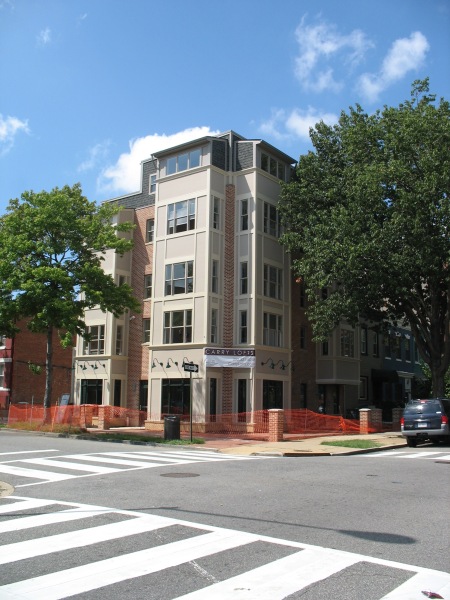Recently, this article from the Washington Examiner showed up on my neighborhood listserv for Hill East. A troublesome carry-out establishment on the Hill, previously a magnet for the drug trade and crime, has been torn down and replaced with a taller, mixed use condominium building with space for ground-floor retail.
The Examiner:
A former Hill East carry-out joint known to be magnet for drugs and violence has been reborn, to some neighborhood dismay, as a condominium and retail complex at the corner of 15th and C streets Southeast not far from RFK Stadium.
…
The criminals dispersed with the carryout’s closure, residents say. But neighbors are not unanimously celebrating its replacement — yet another condo building, one of three relatively new towers on the same block.
“You’ve created on this one block, condo alley,” said Neil Glick, Hill East advisory neighborhood commissioner. “You’ve totally destroyed the character of a residential street of houses. I don’t think it’s progress at all.”
Jim Myers, longtime Hill East activist, dubbed the redeveloped block “Condo Canyon.”
“To understand why some neighbors are irate, you must realize that they endured decades of violence outside the New Dragon and environs, and gained a few moment’s peace that was quickly replaced with the sound of heavy machinery tearing down buildings,” Myers wrote on the neighborhood listserve. “And then the new buildings went up and up until the sun and sky were not to be seen again.”
This is why I can’t stand NIMBY arguments. Mr. Myers just equated a problematic business establishment, crime, shootings, and the like with positive reinvestment in the community. The classic NIMBY defense, using the ‘shotgun’ approach of raising every conceivable objection (no matter if some of them are contradictory) and seeing what sticks.
Richard Layman offers his perspective:
In any event, the block isn’t destroyed and neither is the rowhouse character of the greater neighborhood. If the cornice/roof line of the building was decent, likely if I lived on the block the addition of this building wouldn’t have bothered me.
Richard also notes that the vast majority of housing units in Ward 6 are rowhouses.
It is true that this is change. But the way it is characterized reflects an incredibly strong parochialism, one that is pretty dismissive of providing a means for new housing to be added and different types of people to be accommodated within extant neighborhoods.
Basically what they are saying is that only people with the means to buy a single family house should be able to live in their neighborhood.
Well said, Richard.
In addition to his points, I’d challenge the NIMBY assertion that these condo buildings represent some massive degradation of their built environment. I went over to the site and snapped a few photos.

This is the building in question. The area is predominantly 2-story rowhouses, but of varying heights. Showing the context of the streets, you can see what this change really means:

I find it curious that Mr. Myers would complain about these buildings blocking out the sun and sky when the gorgeous old trees along the street are taller than the buildings in question and block out much more of the sun.
Also, this is part of DC’s L’Enfant City. The other notable thing from this picture is the width of 15th street. These buildings are hardly out of scale with the urban design of the area. These 4-5 story buildings aren’t exactly miniature Empire State Buildings.
It’s also worth noting the value to the city as a whole benefits from this kind of surgical infill development. Adding density at key locations, particularly in places such as this within easy walking distance of a Metro station (Potomac Ave) and two grocery stores, is a good thing for the city as a whole. If the NIMBY folks wanted a better retail establishment, it’s worth noting that neighborhood-serving retail in a location like this doesn’t just magically appear, it comes into being with the support of local residents. Adding density with a few condo units here and there is a fantastic way to increase the livability of the area. It’s a positive feedback mechanism – adding density provides more opportunities for retail, making the area more attractive for residents and visitors alike.
Additionally, Richard Layman already noted the benefit in having multiple price points and multiple housing varieties in a neighborhood.
Unlike Mr. Glick and Mr. Myers, I do think this is progress and Hill East will be a better place because of it.






